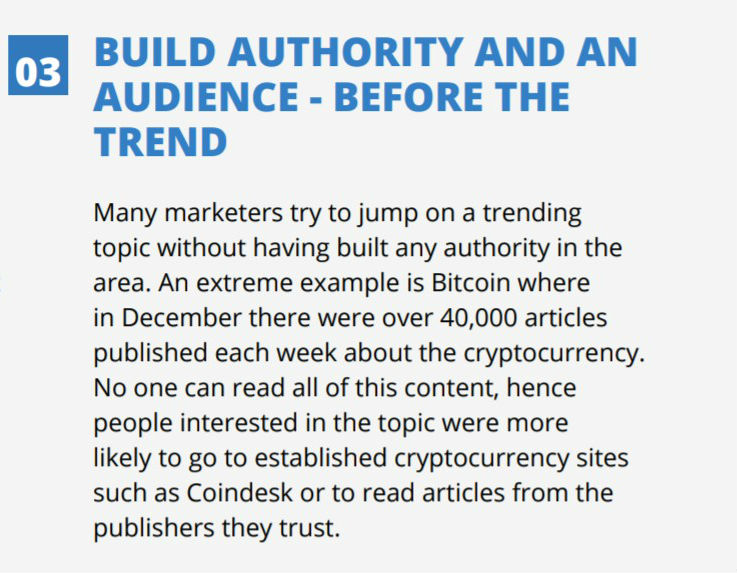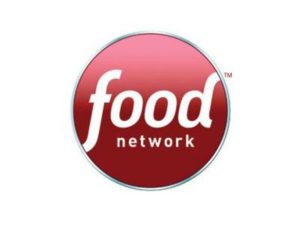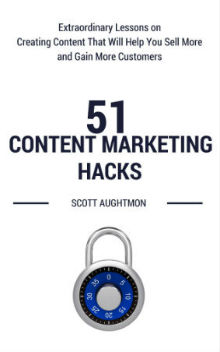Food Network’s Little-Known Content Marketing Origin
You are about to hear a little-known story that reveals how content marketing was secretly involved in the creation of Food Network.
It’s a really intriguing story that involves a powerful Hollywood agent and one of the co-creators of cable TV’s 24-hour news industry.
It’s a story that will reveal to you how people in these top positions think about content and audiences, but it will also reveal something much more important than that.
If you’re a content marketer or company that is finding social media to be less and less effective, then pay very close attention.
Because I’m about to reveal to you a strategy to reach and expand your audience without relying solely on social media.
If you’re open to thinking about social media in a different way than the rest of the crowd, then keep reading.
You’re about to discover how to not be held captive by the social media treadmill but to instead break free from it and make it serve you.
Would you like to WATCH and LISTEN to the story I am about to tell instead of reading it?
If you’d rather read this post, then scroll down and you can continue reading it…
The Podcast Episode That Revealed a Big Secret

I was listening to one of my favorite podcasts, I Love Marketing, awhile back when I heard something I wasn’t expecting.
I heard a content marketing secret about the origins of Food Network. No, they didn’t call it a content marketing secret, but when I heard the story I instantly knew that’s what it was.
Let me explain…
The episode I was listening to that day was episode #301 and the guest that they had on was a guy named Shep Gordon. He’s an American talent manager, Hollywood film agent, and producer.
He began as an agent for Alice Cooper and went on to represent many different famous people. Here are just a some of the people he’s represented:
Luther Vandross, Ben Vereen, George Clinton, Groucho Marx, Kenny Loggins, Pink Floyd, Pointer Sisters, Raquel Welch, Rick James, and many others.
His personal story and his view of fame were really interesting.
But what caught my attention was the fact that he is the person who built what is now known as the “Celebrity Chef Genre”. What that means is that, except for a few people like Julia Child, celebrity chefs didn’t really exist.
That is until Food Network and Shep Gordon got together and changed all of that.
No Wealthy Chefs Before Food Network?
Now before you learn about how content marketing played an integral role in the creation of Food Network, you need to realize something important.
Before Food Network, there were no chefs making a $100,000 a year, not even the top chefs. And no chef had more than one restaurant.
There were top chefs. There were famous chefs. But none of them had what anyone would have considered a “celebrity” status or lifestyle.
Well, after seeing the discrepancy between his high profile clients and top chefs, Shep decided to change all of that.
And the strategy that he decided to use was an ingenious one. It’s one that he learned after observing and being a part of the making of so many top stars.
Pay close attention, because in just a little bit you’ll learn how this strategy could save you from being an on-call servant to social media.
Shep Gordon’s Strategy: Build “Delivery Systems” to Reach and Expand Your Audience
Shep realized that top artists like Michael Jackson had what Shep calls “delivery systems” which enabled them to become huge stars.
Shep said that without things such as radio, TV, and later MTV, Michael Jackson would have never become as big of a star as he did. Those delivery systems delivered him to larger and larger audiences, which made him the superstar he became.
But when Shep looked at the top chefs, he realized that the only delivery systems they had were their restaurants.
And those delivery systems were very limited. People were either in their restaurant or they weren’t. Shep described the problem like this, “With 80 seats, if that’s the only way you touch your audience, then you’re going nowhere.”
After thinking about this for a while, he approached many of the top chefs he knew and explained the problem to them.
But he not only explained the problem, he proposed a solution to them.
He said, “So let’s build some highways. Let’s get a TV network to broadcast you. Let’s get pots and pans in stores, books on the shelves, and videos that people can buy. Let’s give them a chance to like you.”
With that strategy in his mind, Shep decided to take action. And to do that, he decided to do what he always did: he tapped into his connections.
 How Content Marketing Was Secretly Involved in the Creation of Food Network
How Content Marketing Was Secretly Involved in the Creation of Food Network
You see, Shep knew Reese Schonfeld, the co-founder of CNN.
And he heard that Reese had announced he was leaving CNN to start another network. He also heard that Reese wasn’t sure what kind of network it would be yet.
Shep realized this was his opportunity. He went to meet with Reese and he asked him if he had considered food as the theme of the channel.
Reese’s response wasn’t too hopeful. He said he didn’t really care for the food world. Not being a person to take “no” for an answer, Shep made Reese an “offer he couldn’t refuse.”
Shep said, “Well, if you do a food network, I can get you all of your talent for free. I’ve already talked to my guys and they’ve agreed to three years free if I can get someone to broadcast. So you’ll have no talent fees.”
Pretty amazing offer, huh?
I was impressed when I heard it. But it was what I heard next that opened my eyes to see Food Network’s content marketing secret…
After Shep told Reese about his chance to have free talent for three years, he then made his move to make sure that this “delivery system” would be a profitable one for his chefs.
He told Reese that in exchange for the free talent, all he wanted was just a spot in each show where the chefs could sell a product (ex. Emeril’s first product was spices).
Did you catch that?
Each Food Network chef, on each food network show, was given permission to not just create content for the network but to also use that content to sell something.
That means that each show wasn’t just content for the network, it was also content that sold a product of some kind!
When I heard this, it suddenly hit me. The foundation of the Food Network empire was built on (and because of) content marketing!
Who knew??
Content Marketers Are In a Very Similar Situation
I’ve thought a lot about this story since I first heard this episode.
And I’ve realized that there are some really critical lessons that companies who use content and content marketers who create content can learn from this story.
In fact, when you see the current state of content marketing and social media marketing you’ll understand the reason why these lessons are so important…
In a recent report from BuzzSumo.com called, Content Trends 2018: BuzzSumo Research Report, Steve Rayson reveals some pretty startling trends.
Here are three of the trends that apply especially to what I am talking about here:
(NOTE: My comments are in the parenthesis.)
- Based on a sample of 100 million posts published in 2017, social sharing of content has been cut in half since 2015. (There’s less sharing going on.)
- The volume of content published continues to increase, and new topic areas get rapidly saturated with content. (There’s more content than ever.)
- In this new world of content saturation and falling social shares, the big winners are sites that have built a strong reputation for original, authoritative content. (Without these things, you’re in trouble.)
That means that most companies using content and most content marketers are in a very similar situation as chefs were before Food Network and Shep got involved.
Why do I say that? Simple.
Social media’s diminishing power now provides most companies and content marketers with less of a delivery system than a restaurant that seats 80 people. (*Don’t believe me? Then read what I reveal in the next section and I guarantee you’ll change your mind.)
So what’s the solution?
Build “delivery systems” to reach and expand your audience!
The Strategy Every Company and Content Marketer Needs to Learn from Shep Gordon
I want to encourage you to download and read BuzzSumo’s and Steve Rayson’s full report (it’s free and no email is required).
But just from what I’ve revealed to you, you can see that the majority of content marketers and companies have the same problem that many chefs had before Food Network.
They have no effective delivery systems!
Social media, the delivery system that companies and content marketers could rely on in the early days of the content marketing revolution, has become more and more ineffective!
I’ve been involved in content marketing since the early days (2011) and I’ve had the opportunity to write for some top sites (examples are here and here). I remember when you could expect to reach a good size audience through social media.
But lately, I’ve noticed that social media isn’t working as well as it used to.
I’m not just talking about personal experience. I’ve been noticing that even the larger sites aren’t getting as much traction with social media as they used to.
Well, Steve Rayson confirmed my assumption in his report. He says that a number of major publishers have seen a fall in total shares. But this is the craziest thing that he shares…
You see? I wasn’t exaggerating when I said that most companies and content marketers have a smaller delivery system than a restaurant that seats 80 people!
With social media, the main delivery channel that most companies and content marketers rely on losing its effectiveness, most companies and content marketers really aren’t better off than chefs used to be before Food Network.
That’s why the same solution that Shep came up with for them is the same one that we must learn and implement: build “delivery systems” to reach and expand your audience.
In fact, this is going to surprise you but look at one of the ten takeaways that Steve Rayson reveals in Content Trends 2018: BuzzSumo Research Report…

Steve goes on to say…
“The average (mean) shares of Bitcoin articles in the last 12 months (6 Feb 17 to 6 feb 18) was 64. Average shares of articles about Bitcoin in the same period published by the New York Times was 2,300 and by Coindesk was 874. The median number of shares was just 4. Over half of the 40,000 articles a week being published on Bitcoin got less than 4 shares. Whilst it is tempting to jump on a trending topic, you need to have built some authority and reputation in the space. This emphasizes the importance of spotting new topics very early and building a reputation and authority.“
Isn’t that what Shep did for chefs and for Reese Schonfeld?
He realized that food-related content could be something that could become popular – before anyone else did.
And that hunch has led to a network with an operating revenue of $932.6 million!
Three Ways to Find or Build Delivery Systems to Reach and Expand Your Audience
Now, I know that finding or building new delivery systems isn’t a strategy that most companies or content marketers have ever considered (or ever even heard of).
But in this day and age, when social media is failing as a sufficient way to reach a larger audience, it’s a critical strategy to consider.
I also know that even if companies and content marketers want to implement this strategy, most don’t have a clue where or how to start.
Why? Because it’s not easy to discover opportunities where you can build new delivery systems before everyone does.
3 Ways to Build New Delivery Systems
Let me give you three things to be on the lookout for, which will help you to see the delivery system opportunities that are all around you, but which most people are blind to:
1. Look for a new channel
That’s what Shep did. He found a new channel for his chefs to be featured on. And in his case, it was a literal channel. But when I tell you to look for a new channel I am not talking about a TV channel (although that might work).
These days a “channel” simply means a way for you to access and communicate with an audience or a way for an audience to access your content.
So finding a new channel could mean:
- Moving from blogging to podcasting
- Moving from podcasting to Youtube
- Moving from Youtube to Webinars
- Moving from Youtube to TV
- Moving from any other online channels to any offline channels
- And the list goes on!
If you want to build a new delivery system, then instead of focusing all of your attention on one channel, like social media, consider getting your presence and content exposure on a new or different channel.
Here’s a story of someone who moved to a new channel and the incredible results that happened when he did…
Case Study: Russel Brunson – A New Channel
In 2013, online marketer, Russell Brunson, was fighting off bankruptcy.
He is a really smart marketer, but despite this fact, one of his companies had still failed. So what did he do? Something that no one would expect.
After years of his friend and podcasting expert, Paul Colligan, encouraging him to start podcasting, Russell decided to finally go for it.
Since Russell was busy, Paul suggested that Russell record the podcast while driving to work in his car. And that is how the “Marketing In Your Car” podcast was born (now known as “Marketing Secrets.“)
So there in the middle of one of his businesses imploding, Russell decided to use a new/different channel. He didn’t know if or how this channel was going to work. But he just went for it.
And so he started to therapeutically just tell his podcast audience of his loses and wins as he strove to rebuild his business and his life. The result? You won’t believe them, but here you go:
- His podcast has become a top-ranking, popular podcast.
- He’s written several top-selling books.
- He built an “Inner Circle” group where 100 clients pay $25,000 a year to be a part of his private group. (And guess what? The majority of people who have become his best clients were first podcast listeners!)
- He built a company called ClickFunnels, which has become the fastest growing non-venture capitalist backed SaaS company.
Does Russell use social media? Of course! But his success didn’t come from social media.
It came from finding and using a new/different channel and that enabled him to build a new delivery system.
So if you want to build a new delivery system, I’d encourage you to do the same thing. Find a new channel! Now, let’s look at the second way you can look for opportunities to build a delivery system.
2. Look for a new niche
If the audience you are currently trying to reach is in a crowded market, where it’s difficult to get attention or stand out, then try a different niche/market.
It doesn’t just give you the chance to access a new delivery channel. It also gives you the chance to create instant authority in that new arena.
Jay Abraham has significantly increased the bottom lines of over 10,000 clients in more than 400 industries, and over 7,200 sub-industries, worldwide.
Jay has dealt with virtually every type of business. He has studied, and solved, almost every type of business question, challenge, and opportunity.
Jay is paid a very significant amount by many top companies. And WHY is he paid so much? Because he comes up with ideas that are worth millions of dollars.
And what’s his “secret?” He borrows ideas from one industry (where it is common) and applies it in a new industry (where it is unknown). And the result? Insanely high levels of success for every company he works with!
If you want to build a new delivery system, then instead of focusing all of your attention on social media, consider taking your presence, content, and expertise out of your current niche and implementing it in a different niche.
- Look for under-served markets/niches
- Look for unused “market space”
Here’s a story of someone who moved from one niche/market to a new niche/market and the amazing things that happened when he did…
Case Study: Ryan Deiss – A New Niche
Ryan Deiss entered into the digital marketing world way back in 1999, when he was a college freshman at University of Texas.
He ended up getting a job with an internet startup that quickly went out of business, but through that experience, he learned how to do basic web design.
So after that company went under, Ryan struck out on his own and began making websites for people and eventually for himself. Believe it or not, the first product he sold online was an ebook on how to make your own baby food.
It was from selling that product that Ryan learned how to drive traffic to a site and how to convert visitors into customers.
From those humble beginnings, Ryan eventually became a go-to expert in the area of traffic and conversion. In fact, he became such an in-demand expert that he put on a conference focused on that subject known as the Traffic & Conversion Summit which still exists today.
After having people ask him over and over if he had a book or a course, he realized there was a market that wanted to know what he knew.
He started out focusing on small business owners but didn’t get the traction he was hoping for. So what did he do? He moved out of that niche into a closely associated niche. He began focusing on the agencies that serve small business owners.
With this new niche in focus, DigitalMarketer.com began offering what that niche needed and wanted: digital marketing training and certifications. That change in niche completely changed the success of his company.
- He currently employs 120 employees.
- He’s gone on to author multiple books.
- Using his niche focusing method, he founded NativeCommerce.com along with over 40 different businesses in various markets such as survival and preparedness, manufacturing, investing and finance, health and beauty, DIY crafts and home improvement, online skills training, and more.
“Everything that we’ve done has come out of recognizing that there’s a market and saying, ‘I think we can serve this market. Let’s do it.’” – Ryan Deiss in an interview on the Hack the Entrepreneur podcast
Now, let’s ask the same question I asked before: Does Ryan use social media? Again, of course, he does! But his success didn’t come from social media.
It came from finding and using a new/different niche and that enabled him to build a new delivery system into a new niche/market.
So if you want to come up with ideas on how to build a new delivery system, then don’t just look for new channels, look for new niches.
Now let’s look at the third way to look for opportunities to build a delivery system.
3. Look locally
Most companies and content marketers are focusing on reaching people who are far away. But you should also focus on those who are near: your local market.
There are local people, companies, and organizations who need and are hungry for the type of content you create.
And if you’re strategic about it, these local individuals and entities can become a new delivery system for you to reach and grow your audience. All you need to do is approach them.
Here’s the story of what happened when I made a move into my local area and the results I’ve already seen happen so far…
Case Study: Myself – Look Locally
I sort of “accidentally” got into marketing.
It all began when I was trying to figure out how to drive traffic to a website I had created in a small, music niche back in 1999.
So I began my own self-study of marketing and discovered that I not only found marketing interesting, it made sense to me, and I was good at it.
In 2002, when the recession hit, I put out an ebook called How Your Business Can Survive And Prosper In A Recession (that’s why my website has that URL). In it, I interviewed 20 top business, marketing, and sales experts who revealed their methods to help business owners survive and prosper in a recession.
That book led to some interviews with a couple radio stations and online interviews (before podcasting). In 2003, I was hired to help with the online and offline marketing for a non-profit on the East Coast.
In 2008, after returning to California, I put out a second volume of my ebook, when the most recent recession hit. And in it, I interviewed 18 more experts.
After receiving positive feedback from free business/marketing consulting that I had done, I moved into paid consulting.
In 2010, I noticed that content marketing was becoming popular and realized I had been unintentionally doing it from the very beginning of my marketing career. So I submitted a blog post to ContentMarketingInstitute.com (CMI) and began regularly writing regularly for CMI and other websites.
In 2015, I took the blog posts I had written about content marketing from my own site, CMI, and other sites and I compiled them into a book that I released on Kindle called 51 Content Marketing Hacks. which was later nominated for Smallbiztrends.com’s 2016 “Small Business Book Awards.”
Now you need to realize something important. Up to this point, I had mainly worked with and helped companies and businesses that were in other states.
At the end of 2016, I saw that a friend was teaching a course for UC Berkeley Extension and I asked him how he got that opportunity. He explained the process and later introduced me to his contact there.
I submitted my name and some ideas and was asked to teach an “Intro to Marketing” course for them. I have since taught that course two times (fall 2017 and spring 2018) and I will be teaching it again this upcoming spring 2019.
But this is what I want you to see. After only teaching this class twice, I have already seen these results:
- This course has given me the opportunity to teach people from key, local companies such as Oracle, PayPal, and NetGear.
- I’ve received testimonials and endorsements from former students (people in important roles at key, local companies).
- It has opened up new opportunities to work with local business owners.
Do I use social media? Just like the others, the answer is yes!
But the momentum and new opportunities I’ve had in the last year or so didn’t come from social media.
They came from me looking locally and that enabled me to build a new delivery system to our local market.
So if you want to come up with ideas on how to build a new delivery system, keep looking for new channels, new niches, and keep looking locally.
Why Does Building a Delivery System Work Better Than Social Media? Simple. Supply and Demand!
If you’re in a market that’s crowded with content on your subject, then your content will automatically be seen as a commodity. It’s a simple case of supply and demand.
That makes it hard for you to differentiate your company or your content. And if your content and social media shares are seen as common, then they will never be seen as valuable.
That means that your content and social media shares will never be worthy of the attention of that market. All the content marketing and social media marketing in the world will never fix that problem.
But, if you move onto a different channel, or into a different niche, or move into your local area, then you tilt the law of “supply and demand” in your favor.
Because the content you’re offering in these three new areas, where your type of content is limited, makes you and your content stand out as unique.
And that automatically makes you and your content more valuable.
This is what I would Value-Positioned Content because you’ve positioned your content in a way that increases its value.
Sidebar: Value-Positioned Content or Value-Created Content
I don’t have time to talk about how providing your content to another market can have a ripple effect and make your content more valuable in your original market.
And I don’t have time to share with you other value-creating ideas here in this post.
But if you’re interested in hearing more about these rare and unique content creation and positioning concepts, then sign-up by email to get your hands on my brand new 34-page content value-creation handbook. It’s called, The 19 Indisputable Laws For Creating Highly Valuable Content: How To Create, Elevate, Or Unintentionally Destroy The Perceived Value Of Your Content.
The premise of my handbook is that in most arenas, content has become a commodity.
This handbook reveals a solution to this problem which involves tapping into the universal laws of what makes something valuable and using them to create or position your content. That way your content’s value is elevated out of the category of commodity and transformed it into a rarity.
Anyway, let’s get back to this post and finish it up with one last idea on how you can effectively build your content on these new delivery systems.
When You Find Your New Delivery System, Think Long-form and Long Haul
By just moving to a new delivery system in one of these three arenas, you’ll instantly sense more momentum than you would have if you just focused on social media.
But you will only see substantial and lasting results when you focus on two important things:
1. Harness the power of long-form storytelling
In a post called Why Marketers Are Embracing Long-form Storytelling, Ann Handley talks about the trend toward long-form storytelling that’s happening now. She says…
“Bottom line: We seek meaning and crave connection. That means marketing needs to slow down and think about substance and context. We also need to focus on the meaning baked into the experience we are giving our audiences.” – Ann Handley
That’s what the chefs on Food Network did. They weren’t just trying to create a quick piece of content like a short 5-minute recipe video you can find on Youtube. They produced content for 30-minute and 60-minute shows.
And they used that long format to tell stories: their own stories, stories about their food, stories about their guests, etc.
It was this long-form story format which gave their audience a chance to know, like, and trust them in the way that short-form, fact-based content never would have.
If you want your company or your content to really succeed in one of the three arenas I’ve suggested, then you must be wise enough to do the same thing.
But there’s one more thing that you need to do.
2. Be in it for the long-haul
In a post from Sujan Patel called, How to Become an Influencer in Any Industry, he says…
“The biggest secret to becoming an influencer in any industry is to create content for years and years. Create content, and then multiply that by years. I’ve been creating content regularly for four years straight now. I’m talking publishing weekly or biweekly – usually multiple pieces of content. I’m emailing my list every single week. Because of that, things fall into my lap that I used to have to chase down. I get speaking gigs because of the content that I created years ago. It’s not the content I’ve created recently. It’s the track record I’ve built over years and years that’s getting me attention.” – Sujan Patel
That’s what the chefs on Food Network did. Shep’s plan wasn’t to just have his chefs do an appearance or two on Food Network.
The plan was to produce seasons of content for each chef.
And so they were in it for the long haul. They were building a content asset, a show that benefited their viewers, build a deep relationship with them, and one that would build fame and authority for whoever’s show it was.
If you want your company or your content to really succeed in one of the three arenas I’ve suggested, then you must do the same.
Before we end, I need to answer one question that’s probably on your mind…
Does That Mean You Should Abandon Social Media and Your Current Channels or Markets?
I am NOT telling you to stop using social media completely. Keep using it!
I am NOT telling you to abandon the current channels and markets that you’ve already invested time and money in.
I AM telling you that if you want to see new results, then doing more of the same thing isn’t the answer. If you want to see new results, then you need to begin to do some different things.
That’s why I AM suggesting that you begin to invest some of your time and money into building a new delivery channel.
And I hope if you’ve read this far, I’ve proven to you from the examples of Food Network and the three business examples, that it’s your only real hope to see the significant results you hope for.
But this is the thing that might surprise you.
- When you build a new delivery system through a new channel, you can still reach the same market. You will just do it through a different means or media.
- When you build a new delivery system through a new niche, you can still reach the same market. You just might end up doing it through a backdoor.
- When you build a new delivery system through local arenas, you can still reach the same market. You just do it first on a more up-close basis.
The Unexpected, Social Media Side-Benefit of Building a New Delivery System
This is what you really need to understand.
The side-benefit of building a new delivery system is that you will begin to see more momentum on social media and within your own market! Why?
Remember what Steve Rayson said?
“In this new world of content saturation and falling social shares, the big winners are sites that have built a strong reputation for original, authoritative content.” – Steve Rayson
As you build original and authoritative content in new channels, new niches, and even locally, your authority in those arenas will grow.
And the people who discover you through these new delivery systems will begin to follow you on social media and see your social media shares not as a commodity, but as a source of quality information.
That will give you a new momentum in your social media marketing that will have a ripple effect back into your original market and niche.
The new prestige gained through these new delivery systems will give you a new unique status in your original market and to your original audience. That will make your company and your content stand out from your competitors.
And guess what happens then?
You will have positioned your content in a way that increases its value (there’s Value-Positioned Content again).
That’s why, while everyone else continues to blindly focus primarily on social media, I want to encourage you to put Shep Gordon’s strategy into action: begin building new delivery systems today!
Bonus Content
One of my and my family’s favorite parts of watching movies on Blu-ray or on Amazon Prime is the “Bonus Features.”
For that reason, I thought I would include below some additional “bonus content” that you might be interested in checking out now that this mammoth post is finished.
- Looking for Ideas for New Delivery Systems? Check out these links:
– Apple Is Getting into Original Content, Where Does That Leave Advertisers? (Shellypalmer.com)
– Facebook Pushes Online Ads, Then Spends Its Cash on Billboards (Bloomberg.com)
– Disney’s streaming service starts to come into focus (CNBC.com) - Listen to Paul Colligan interview Russell Brunson on The Podcast Report. Hear how Russell started his podcast and the ingenious ways he has leveraged it. Go here to listen now.
- Listen to Ryan Deiss’ interview with Jonny Nastor on the Hack the Entrepreneur Podcast. Hear why Ryan says that you should aim to become a channel business. Go here to listen now.
- Listen to Jay Abraham’s podcast called The Ultimate Entrepreneur Podcast. Hear Jay share some of his legendary wisdom in a way that only he can do. Go here to listen now.
- Listen to Sujan Patel’s Growth Mapping Podcast. Hear his marketing and business growth ideas for 2018. Go here to listen now.
- Listen to the latest episode of the I Love Marketing Podcast. Hear the amazing marketing insights that Joe Polish, Dean Jackson, and their guests share on this podcast. Go here to listen now.
- Read Ann Handley’s book Everybody Writes: Your Go-To Guide to Creating Ridiculously Good Content. Discover why writing matters more—not less—if you want to attract and retain customers. Go here to grab a copy.
- Read my free handbook on value-created content (VCC) and value-positioned content (VPC). Grab a free copy and learn how to tap into the universal laws of what makes something valuable and use them to create or position your content so it becomes more valuable to the market. Click here to grab a copy of The 19 Indisputable Laws For Creating Highly Valuable Content: How To Create, Elevate, Or Unintentionally Destroy The Perceived Value Of Your Content. (NOTE: In the handbook, you’ll also learn how to subscribe to my premium podcast on the same subject.)
- Watch the video from Nola.com below and learn how Emeril became famous…
















